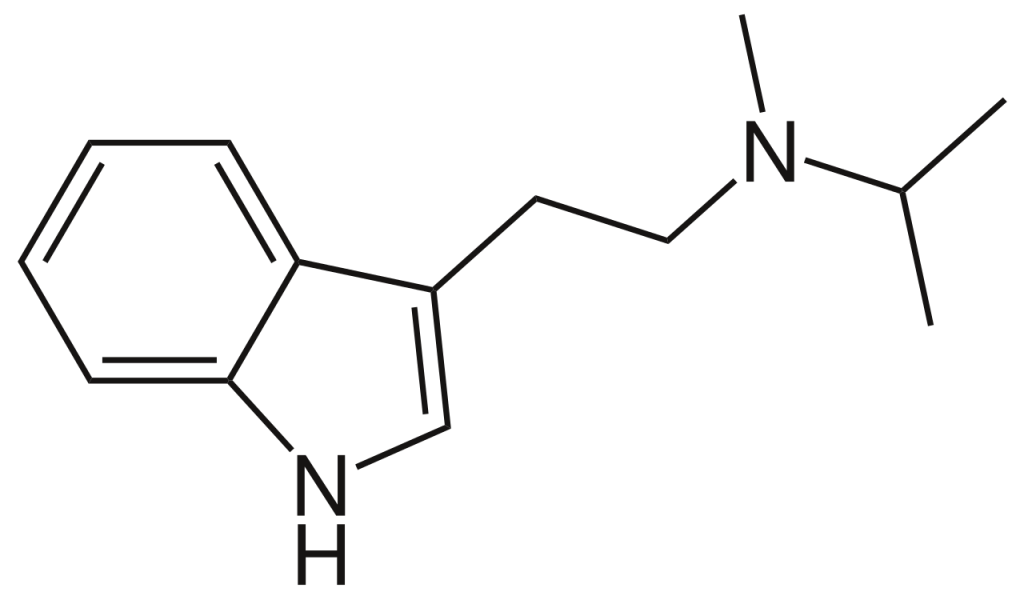Summary
N-Methyl-N-isopropyltryptamine (MiPT) is a psychedelic tryptamine compound that shares a close structural relationship with DMT, DiPT, and Miprocin.
| Identifiers | |
|---|---|
| IUPAC name | |
| CAS Number | 96096-52-5 |
|---|---|
| PubChem CID | 29935323 |
| ChemSpider | 21106353 |
| UNII | JO3SCR302A |
| ChEMBL | ChEMBL353728 |
| Chemical and physical data | |
| Formula | C14H20N2 |
| Molar mass | 216.328 g·mol−1 |

Chemistry
MiPT base distinguishes itself from many other tryptamines in its free form by displaying a remarkable resistance to rapid decomposition in the presence of light or oxygen.
In August 2019, Chadeayne et al. successfully determined the crystal structure of MiPT fumarate. Its systematic name is 2-(1H-indol-3-yl)ethylpropan-2-ylazanium 3-carboxyprop-2-enoate. The salt is composed of a protonated tryptammonium cation and a 3-carboxy acrylate (hydrogen fumarate) anion within the asymmetric unit.
Dosage
10-25 mg is usually taken orally, with effects lasting 4–6 hours.
Effects
MiPT is known to place greater emphasis on inducing psychedelic and entheogenic experiences, with fewer sensory or hallucinogenic effects reported by users. Users commonly describe robust mental effects while experiencing minimal perceptual distortions. Additionally, heightened sound sensitivity is often noted.
Legality
On May 15, 2019, Sweden’s public health agency proposed categorizing MiPT as a potentially harmful substance.
In the United States, MiPT is classified as a Schedule I controlled substance due to its status as a positional isomer of Diethyltryptamine (DET). MiPT is explicitly listed by name in the DEA Controlled Substance Orange Book.
FAQ
1. What is Methylisopropyltryptamine (MiPT)?
- MiPT is a chemical compound belonging to the tryptamine class, known for its psychedelic and psychoactive properties.
2. Is MiPT legal in the United States?
- The legal status of MiPT can vary, but it is often not controlled at the federal level. However, its legality may vary by state or locality, and it is important to check local regulations.
3. How does MiPT differ from other tryptamines like DMT or psilocybin?
- MiPT has a distinct chemical structure and psychoactive profile, which can result in unique subjective experiences. It may differ from more well-known tryptamines in terms of effects and duration.
4. What are the effects of MiPT?
- MiPT is known for its psychedelic effects, such as altered perception, introspection, and changes in consciousness. However, its specific effects can vary from person to person.
5. Is MiPT safe to use?
- The safety of MiPT needs to be well-researched, and its long-term effects need to be better understood. Responsible and cautious use is recommended, especially if you have no prior experience with it.
6. What are the potential risks associated with MiPT use?
- Like other psychedelics, MiPT use may involve potential risks such as psychological distress, anxiety, and hallucinogen-persisting perception disorder (HPPD). It is important to consider set and setting when using MiPT.
7. How is MiPT typically consumed?
- MiPT is often ingested orally, either in its pure form or as a powder. Other methods of administration, such as snorting, are less common.
8. Can MiPT be used for therapeutic purposes?
- There is limited research on the therapeutic potential of MiPT, and it is not approved for medical or therapeutic use. Other psychedelics, like psilocybin and MDMA, have been more extensively studied for therapeutic applications.
9. Is MiPT addictive?
- The addictive potential of MiPT is not well understood, but it is generally considered to have a lower risk of physical dependence compared to substances like opioids or stimulants. However, psychological dependence can still occur.
10. Where can I find more information about MiPT?
- Given the evolving legal and scientific landscape surrounding MiPT, it is important to consult reliable sources of scientific literature and seek advice from healthcare professionals. Staying informed and making well-informed decisions is crucial when considering the use of this substance.
References
- Chadeayne and colleagues published a study in September 2019, titled “N-methyl derivatives of DMT and psilocin,” in Acta Crystallographica Section E (Volume 75, Part 9, Pages 1316–1320). You can find this research by following the DOI: 10.1107/S2056989019011253. Additionally, the publication is indexed under PMC (PubMed Central) with the reference PMC 6727059, and its PMID (PubMed Identifier) is 31523457.
- The Swedish public health agency, Folkhälsomyndigheten, proposed on May 15, 2019, that 20 substances be classified as narcotics or hazardous goods. You can find more details about this proposal in Swedish.
- The Drug Enforcement Administration (DEA) maintains the “Orange Book,” which lists controlled substances and regulated chemicals. The information is accessible in a PDF format, and the document was last archived on March 6, 2023. This resource provides valuable information about substances and chemicals subject to legal regulation.